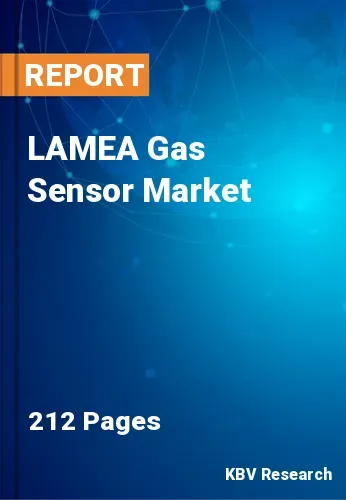The Latin America, Middle East and Africa Gas Sensor Market would witness market growth of 10.8% CAGR during the forecast period (2023-2030). In the year 2026, the LAMEA market's volume is expected to surge to 916.8 thousand units, showcasing a growth of 12.9% (2023-2030).
Wireless connectivity solutions, like Bluetooth and Wi-Fi, are becoming standard features in gas sensors. This facilitates seamless communication between sensors, control systems, and other devices, promoting a more interconnected and responsive ecosystem. The demand for compact and lightweight solutions drives the trend toward miniaturization and portability of these. This is particularly relevant in applications such as wearable devices for personal safety and environmental monitoring in challenging terrains.
Selective sensing technologies, which enable high-precision identification and quantification of specific gases, are gaining traction. This innovation is vital in applications where detecting a particular gas is crucial, such as medical diagnostics and industrial processes. Innovations in energy harvesting solutions, such as self-powered sensors using ambient energy sources, contribute to the sustainability of gas sensor deployments. This reduces the reliance on traditional power sources and enhances the autonomy of sensor systems.
As per the International Trade Administration (ITA), the United Arab Emirates will be among the world's top ten oil producers in 2022. Approximately 96% of the nation's estimated 100 billion barrels of known oil reserves are in Abu Dhabi, ranked sixth globally. On average, 3.2 million barrels of liquid and petroleum products are produced daily in the UAE. With the UAE being a key player in the energy sector, these are being placed to safeguard the safety of persons and assets by providing early indications of gas leakage. Due to these aspects, the market will expand across the LAMEA region in upcoming years.
The Brazil market dominated the LAMEA Gas Sensor Market by Country in 2022 and would continue to be a dominant market till 2030; thereby, achieving a market value of $89.5 million by 2030. The Argentina market is showcasing a CAGR of 11.4% during (2023 - 2030). Additionally, The UAE market would register a CAGR of 10.5% during (2023 - 2030).
Based on Type, the market is segmented into Wired and Wireless. Based on Product, the market is segmented into Carbon Dioxide (CO2) Sensors, Carbon Monoxide (CO) Sensors, Oxygen (O2)/Lambda Sensors, Nitrogen Oxide (NOx) Sensors and Others. Based on Technology, the market is segmented into Electrochemical, Solid State/MOS, Infrared (IR), Catalytic, Photo-ionization Detector (PID) and Others. Based on End User, the market is segmented into Industrial, Environmental, Medical, Agriculture, Petrochemical, Building Automation & Domestic Appliances, Automotive and Others. Based on countries, the market is segmented into Brazil, Argentina, UAE, Saudi Arabia, South Africa, Nigeria, and Rest of LAMEA.
Free Valuable Insights: The Worldwide Gas Sensor Market is Projected to reach USD 3.5 Billion by 2030, at a CAGR of 9.4%
The market research report covers the analysis of key stake holders of the market. Key companies profiled in the report include Siemens AG, Robert Bosch GmbH, Amphenol Corporation, ABB Group, GfG Gesellschaft für Gerätebau mbH, Honeywell International, Inc., Dragerwerk AG & Co. KGaA, Process Sensing Technologies, Tokuyama Corporation, and Nemoto & Co.,Ltd.
By Type (Volume, Thousand Units, USD Billion, 2019-2030)
By Product (Volume, Thousand Units, USD Billion, 2019-2030)
By Technology (Volume, Thousand Units, USD Billion, 2019-2030)
By End User (Volume, Thousand Units, USD Billion, 2019-2030)
By Country (Volume, Thousand Units, USD Billion, 2019-2030)

Our team of dedicated experts can provide you with attractive expansion opportunities for your business.

